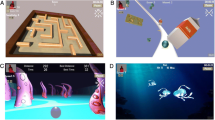Abstract
Consumer gaming platforms such as the Nintendo Wii and Xbox Kinect have been used for therapeutic purposes with varying levels of success. One limitation is the fact that most commercially available video games are designed for the general population and are often overwhelming and difficult for patients to use that present with motor and cognitive impairments as a result of brain injury. Specialized therapeutic medical devices are not only expensive and non-portable, they also make limited use of video games features to better engage and motivate the patient. This study aims to overcome these shortcomings and provide game developers and stakeholders with a more nuanced understanding of how video game technology can be effectively used for physical therapy. A collaborative initiative involving a group of software developers, hardware designers and physical therapists, set out to identify and address the issues that have made the adoption of existing game platforms for therapeutic purposes problematic in a clinical setting. The outcome of this initiative is PocketPT – a personalized therapeutic game platform that provides a therapist designed and configured therapeutic game experience that is customized for a particular patient’s unique presentation. Results from an initial clinical study with participants with brain injuries are reported and discussed.
Article PDF
Similar content being viewed by others
Avoid common mistakes on your manuscript.
References
E. Zaloshnja, T. Miller, J. Langlois, & S. Anbesaw, (2008). Prevalence of Long-Term Disability from Traumatic Brain Injury in the Civilian Population of the United States, 2005. Journal of Head Trauma Rehabilitation, 23(6), 394–400.
M. Agmon, C. Perry, E. Phelan, G. Demiris, & H. Nguyen, (2011). A pilot study of Wii Fit exergames to improve balance in older adults. J. Geriatr. Phys. Ther., 34(4), 161–167.
J. Huang. “Kinerehab: a kinect-based system for physical rehabilitation: a pilot study for young adults with motor disabilities,” in Proceedings of the 13th International ACM SIGACCESS Conference on Computers and Accessibility, 2011, ACM, New York, NY, USA, pp. 319–320.
Clinic of Metairie, OrthoPtic Rehab 2010, Available: http://www.orthorehabofmetairie.com/trazer-3d.htm .
NeuroCom’s Smart EquiTest Product Page, Available: http://www.onbalance.com/products/EquiTest/detail.php .
J. Sietsema, D. Nelson, R. Mulder, D. Mervau-Scheidel, and B. White, “The use of a game to promote arm reach in persons with traumatic brain injury,” American Journal of Occupational Therapy, vol. 47, no. 1, 1993, pp. 19–24.
T. O’Connor, R. Cooper, S. Fitzgerald, M. Dvorznak, M. Boninger, D. VanSickle, and L. Glass, “Evaluation of a manual wheelchair interface to computer games,” Neurorehabilitation and Neural Repair, vol. 14, no. 1, 2000, pp. 21–31.
L. Widman, C. McDonald, and T. Abresch, “Effectiveness of an upper extremity exercise device integrated with computer gaming for aerobic training in adolescents with spinal cord dysfunction, Journal of Spinal Cord Medicine, vol. 29, no. 4, 2006, pp. 363–370.
A. Plotkowski, and N. Barakat, “A new device to quantify human trunk-control measurements”, in Proceedings of the ASME 2010 International Mechanical Engineering Congress & Exposition, Vancouver, British Columbia, Canada. November 2010.
Newstead, A., Hinman, M., & Tomberlin, J. (2005). Reliability of the Berg Balance Scale and Balance Master Limits of Stability Tests for Individuals with Brain Injury. Journal of Neurologic Physical Therapy, 29(1), 18–23.
Gorman, S., Radtka, S., Melnick, M., Brams, G., & Byl, N. (2010). Development and validation of the function in sitting test in adults with acute stroke. Journal of Neurologic Physical Therapy, 34(3), 150–160
Beel-bates, M., Anderson, K., & Gardner, M. (2011). Intra-rater reliability, inter-rater reliability, and concurrent validity of a new Prototype measuring trunk control in sitting in individuals with stroke and brain injury. Grand Valley State University.
Betker, A. L., Desai, A., Nett, C., Kapadia, N., & Szturm, T. (2007). Game-based exercises for dynamic short-sitting balance rehabilitation of people with chronic spinal cord and traumatic brain injuries. Physical Therapy, 87(10), 1389–1398. doi: 10.2522/ptj.20060229
Godi M Franchignoni F et al. (2013). Comparison of reliability, validity, and responsiveness of Mini BESTest and Berg Balance Scale in patients with balance disorders. Phys Ther 93: 158–167
Author information
Authors and Affiliations
Additional information
This article is distributed under the terms of the Creative Commons Attribution License which permits any use, distribution, and reproduction in any medium, provided the original author(s) and the source are credited.
Rights and permissions
Open Access This article is distributed under the terms of the Creative Commons Attribution 2.0 International License ( https://creativecommons.org/licenses/by/2.0 ), which permits unrestricted use, distribution, and reproduction in any medium, provided the original work is properly cited.
About this article
Cite this article
Engelsma, J., Gamble, A., Harro, C. et al. PocketPT – A Personalized Therapeutic Game Platform. GSTF J Comput 3, 41 (2014). https://doi.org/10.7603/s40601-013-0041-x
Received:
Accepted:
Published:
DOI: https://doi.org/10.7603/s40601-013-0041-x




